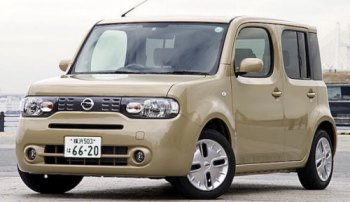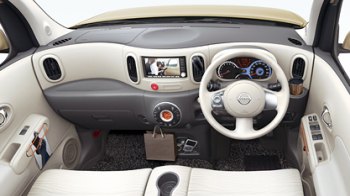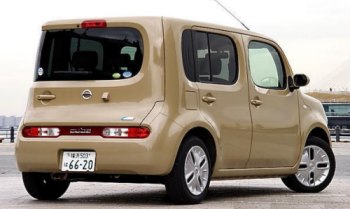|

|
Nissan make a more ambitious plan for
Mk3 - it will be a "world car"...
|
Around 20 years ago Nissan
produced a series of funky icon cars - Be-1, Figaro, Pao and S-Cargo -
which reversed the conservative image of the Japanese giant.
Unfortunately, the series came to an end following the arrival of a
decade-long economic recession. During difficult times, what Japanese
motorists needed were cheap and practical cars. Therefore in 1998
Nissan introduced Cube. The original Cube was so named because of its
boxy body, which was oriented for practicality rather than style.
However, the real commercial success came in 2002 with the second
generation Cube. This car combined the practicality of the original car
with a really funky design. Taking advantage of the reviving economy,
it caught the hearts of Japanese young motorists and, surprisingly,
became the best selling Nissan in Japan. Cube Mk2 proved that an icon
car
can also be a volume model.
With the success of Mk2, Nissan make a more ambitious plan for Mk3 - it
will be a true "world car", going on sale in Japan, Europe as well as
North America. Production volume will be significantly increased. The
car would be engineered to higher standards in terms of quality and
dynamics in order to meet the expectation of overseas drivers. As
before, the car is derived from the Renault-Nissan B-platform which
also underpins Nissan March (Micra), Tiida (Versa), Note (Tone),
Renault Clio and Modus. The basic architecture is conventional, with
front-wheel drive, suspensions of MacPherson struts and torsion beam,
electrical assisted rack-and-pinion steering and only one combination
of engine (Nissan HR15DE 1.5-liter 16V) and transmission (Xtronic CVT).
Also like the last generation, Nissan’s e-4WD system is optional (it
uses an electric motor to drive the rear wheels on part-time basis).
European version will offer a choice of 1.6 petrol and diesel engines
plus a manual gearbox. American version will offer a larger 1.8-liter
engine to consume their cheaper gas.

|
The cabin feels as warm as your living
room...
|
Unquestionably, the
most
important to this car is still its styling and packaging. Basically,
the Mk3 retains the general shape and format of the old car, including
the asymmetric design side-hinged tailgate. However, it rounded the
sharp edges of the old car and tweaked the details to be more funky.
New features include a new design headlamps and taillights, a smaller
front grille, smoother flared fenders and round window apertures.
Myself prefer the simplicity of the old design, but you can’t deny that
the new car delivers a finer finishing and much improved packaging
quality. Such progress is supported by advancer computer modeling
software and production technology.
While I am not totally agree with its exterior design, the interior is
definitely a huge improvement from the old car. It features a stylish
wave-style dashboard and a water ripple roof lining to stand out from
other hatchbacks or MPVs. Its plastics and fabrics are high quality, if
not as good as the best European offerings. The thick cushion seats
feel as comfortable as sofas, while the whole cabin feels as warm as
your living room. High seating position (hip point) and solid A, B and
C-pillars mean you will feel like driving a Hummer. Rear passengers sit
even higher, so they enjoy a good view forward. Everybody enjoy
excellent head and legroom because the new Cube is once again enlarged.
Now it is 160 mm longer, 25 mm wider, 10 mm taller and runs a 100 mm
longer wheelbase. Our only criticism is its limited versatility despite
of its mini-MPV appearance. Its rear seats can 40/60 split and fold, or
slide back and forth to allocate luggage and passenger room, but so do
most hatchbacks nowadays. It would have been better if its rear seats
can fold flat into the floor, or its luggage compartment provide some
flexible parcel shelfs.

|
I doubt if history will see it as a
design icon like the Mk2...
|
The previous Cube was designed
exclusively as a city car for use in Japan, so its handling and
high-speed refinement was a joke. Unquestionably, the new requirement
to satisfy European and American drivers helps improve its dynamics.
The Mk3 has a stronger chassis, better dampers, thicker anti-roll bars,
stiffer rear springs and retuned steering. These improvements translate
to less body roll, calmer ride and more faithful steering. It is still
not a driver's car - no cars as tall as 1650 mm could be - but it would
be a decent machine to spend most of its life in London or L.A. The
combination of 109-horsepower HR15DE engine and Xtronic CVT is also
surprisingly peppy, more so than in the old car. You can expect 0-60
mph in 11 seconds and 105 mph top speed, not bad.
Boosted with higher quality, better interior and improved dynamics,
Cube Mk3 is destined to be another success. However, I doubt if history
will see it as a design icon like the Mk2. Sometimes more does not
equal to better. |